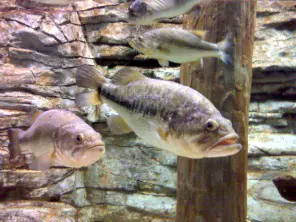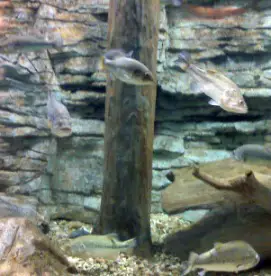Where To Find Largemouth Bass During Any Season
Knowing where to find bass is probably the most important thing to understand about largemouth bass fishing.
You can head out to your favorite lake known for lunker bass with the newest reel, strongest rod and a tackle box full of the next hot lures. You've done your research on the the best bass fishing rigs to use and even practiced tying the strongest knots known to man to make sure you don't lose that pig while your reeling him in. But all that is worthless if you don't know where to look.
Jump To:
Knowing where to look for largemouth bass is obviously an important component in having a successful fishing day. I mean you could go blindly and just toss lures out into any sporadic place on the water and you could maybe catch something but more often than not, this will result in a frustrating fishing trip.
And while a good fish finder is a very valuable tool to have, you still have to have an idea of where to get started in order to maximize your time on the water and then use that tool to get major bass in the boat.
Its best to have some target areas in mind when heading in search of your next trophy bass. And to identify those target areas you need to understand how bass react to the different conditions not only on any given day but on any given day in the current seasonal conditions. This is what is referred to as a "pattern".
Here are some guidelines to help you pinpoint some areas that could be holding bass and make for a productive trip.
The Difference Between Structure and Cover
First lets define the most used terms when talking about where to find largemouth bass. Structure and cover.
Structure is the layout of the body of water. I was going to say the naturally occurring features of the lake such as points, humps, flats and creek or river beds but it also includes old roads that were in the area before the lake was filled in and those are not necessarily naturally made.
Cover is a place where bass could, well, take cover or hide to ambush prey. Common examples of cover would be any sort of vegetation, boat dock, bridge piling, a tree stump, a rock or brush pile or even something not naturally occurring like wreckage or a man made object.
So you could have areas of cover that are contained on structure, such as stumps on a point or brush piles on a drop-off. Or you could have cover by itself such as grass mats or lily pads.
Finding Fall Largemouth
In fall you should be looking shallow. Bait fish will be hanging out in the backs of creeks and the bass won't be far behind. You should also check windblown shorelines, especially those with any kind of structure present or cover near by. Tossing lures to isolated cover could be very productive.
Another spot to focus on are flats that also contain isolated cover or have a good dropoff on them. Working your lures from the shoreline back to the dropoff will spark the interest of any hungry largemouth bass that may be near by.
*See more Fall Bass Fishing Tips.
Locating Winter Largemouth Bass
In the winter, when the water reaches the low 50s or lower, largemouth will retreat back to deeper water. This is when you will want to key in on deep structure on your chosen lake.
Steep dropoffs near creek beds are a popular place for largemouth bass to be found. Points that taper off into the deeper parts of the lake should be worked along with any lake humps.
Once again be on the look out for any cover that you may be able to mark on your fish finder on the deeper parts of the lake especially near creek beds. Brush piles or tree stumps are a favorite hiding spot and could be the key to finding big largemouth bass in the winter.
*Check out more on Winter Bass Fishing.
Finding Spring Largemouth Bass
This is largemouth bass spawn season. The bass will come back into the shallow areas. Pay particular attention to shallow, flat areas in and around coves.
You also want to look for primarily sandy areas rather than rocky or areas with thick vegetation. Keep in mind that at this time bass are looking for areas to make a nest. Areas that a bass can fan out and clear a spot for a nest that he will eventually guard from the dangers of the lake. Look for spots with the characteristics named above and that look "safe" to a largemouth.
Where to Find Summer Largemouth
As the days heat up in the transition from Spring to Summer you will once again find the bass in deep water for most of the day.
While early morning and late evening will still have some largemouth bass going shallow to feed, most of the day should be focused on off shore structure.
Similar to winter when you want to be working areas of the lake where you find off shore humps and points. Creek beds can prove to be productive and any area around these where there is a transition in the make up of the bottom of the lake. Such as a rocky bottom turning into sand.
There will be some variances depending on the part of the country you are in and some of the seasonal patterns will start earlier or later again depending on your location. As with anything in fishing learning where to find largemouth bass ultimately takes time out on the water. And using these guidelines, you should be well on your way to making your day more productive and locating those largemouth bass.
Go from "Where To Find Largemouth Bass" back to see more on Largemouth bass fishing.
Go to our home page to see even more bass fishing tips.


New! Comments
Let us know what you think! Leave us a comment in the box below.